Clockmaking was a skilled trade among certain Mennonites for more than two centuries, and a striking exhibit at Gallery in the Park in Altona, Manitoba, displays the art and heritage of the Kroeger clocks, as they are commonly known.
With the rise of the Industrial Revolution, clocks became a common feature in Mennonite homes in eastern Europe, bringing beauty, practicality and order. Today, over 475 Mennonite-made clocks are known to survive. The “Keeping Time” exhibit features more than 20 clocks made in what are now Poland and Ukraine.
The exhibit is presented by the Kroeger Clocks Heritage Foundation (KCHF) in partnership with the Mennonite Heritage Village (MHV).
“I think what [the exhibit] does for people is it ties together the migratory movements of Mennonites, but then it also gives them a different window into what types of things were cherished in early Mennonite life,” says Susie Fisher, curator at Gallery in the Park.
“Many people can’t believe someone leaving Ukraine at a time of unrest would think to take their clock, but then you recognize the sentimental value,” Fisher adds. “They didn’t have a lot of artwork . . . and this was the soul of the home in some ways.”
The KCHF aims to preserve the history of Mennonite clocks. It was founded by H. Elizabeth (Liza) Kroeger, a descendant of the Kroeger clockmakers. She wanted to continue the work of her father, Arthur Kroeger, who attended First Mennonite Church in Winnipeg and died in 2015. He documented and researched at least 250 surviving clocks and worked to restore some of them.
The foundation previously mounted an exhibit in 2018 at the MHV in Steinbach, Manitoba, and it hosts a virtual museum at kroegerclocks.com.
Canadian Mennonite spoke with five people who were involved with creating the exhibit in Altona about their favourite clocks.
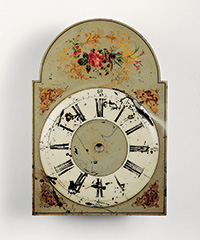 The Makhno Clock
The Makhno Clock
During the Russian revolution, marauding anarchists led by Nestor Makhno destroyed many Kroeger clocks. Makhno was in a home in the Chortitza Colony when a Kroeger clock struck the hour. Startled, Makhno tore the clock from the wall and trampled on it. When he left, the family collected the pieces, which survive to this day.
“I think it’s a really neat symbol for what this family experienced,” says Jenna Klassen, a KCHF board member and former curator at MHV. “The clock itself witnessed this history that was a big part of the Mennonite experience in Ukraine.”
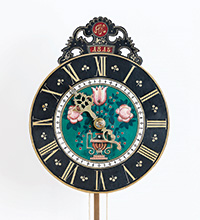 The Rosenthal Clock
The Rosenthal Clock
Created by Kroeger clockmakers circa 1815, this round clock features a crown, a black border, gold roman numerals and a floral image. The motif of a vase filled with flowers is a common one found in Mennonite fraktur (a form of folk art).
“It’s such a beautiful historic antique example, but it’s also graphically stunning,” says Anikó Szabó, a founding member of the KCHF. “The colours, the type of paint Arthur used when he restored it—it’s just simply gorgeous.”
Szabó served as graphic designer for the exhibit in Altona and the KCHF website, which includes many high-quality photographs.
“That’s one of the delightful things about this project and the website,” Szabó says. “We were able to reproduce and capture the beauty of these pieces.”
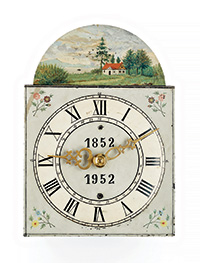 The Housebarn Clock
The Housebarn Clock
Little is known about Gerhard Hamm, the clockmaker who created this piece in 1852. What is known is that the clock was brought to Manitoba, circa the 1870s, and then taken to Mexico in the 1920s or 1940s.
Jacob Wiebe of Hochfeld, Manitoba, went to Mexico around 1969 to visit family. He purchased the clock and brought it back to Manitoba. A collector purchased the clock from him a few years later and donated it to the Manitoba Museum in Winnipeg in 1975.
“It’s really travelled around the world,” says Roland Sawatzky, curator of history at the Manitoba Museum and friend of the late Arthur Kroeger.
The clock face depicts a pastoral scene that includes a house next to a lake, with mountains in the background. While the clock was still in Mexico, its face was repainted and the movement repaired, likely in 1952.
“That’s the thing about these clocks—they last so long that whatever frailties they might have get repaired or covered,” Sawatzky says. “They’re really living artifacts.”
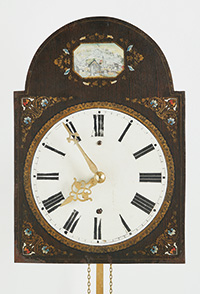 The Cityscape Mandtler
The Cityscape Mandtler
Gerhard Mandtler (1821-1904), who made this clock in 1865, was at least a fifth-generation clockmaker.
“I love it because it’s beautiful and it’s a bit of a mystery,” says Alexandra Kroeger, a descendant of the Kroeger clockmakers and the KCHF’s lead researcher.
The clock face is original and is painted in a wood-grain pattern, which was common in Mennonite-made furniture but unique for Mennonite clocks.
Adding to the clock’s uniqueness is the picture at the top. The vast majority of the clocks Alexandra Kroeger is aware of depict flowers, but this one shows a cityscape.
“Arthur Kroeger thought it was Zurich, but I don’t think so,” she says. “The mystery of what place it’s depicting really engages my curiosity.”
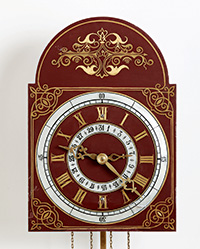 The Schulz Clock
The Schulz Clock
Created during the peak period of Kroeger clock manufacture, between 1890 and 1910, this clock was commissioned by a wealthy Mennonite factory owner and would have been one of the most expensive models Kroeger clockmakers made.
The clock has special significance to KCHF board member Alexandra Olivia Zeitz, the daughter of Liza Kroeger and granddaughter of Arthur Kroeger. The clock belonged to Arthur’s maternal grandparents, and it was the first clock that he restored, repaired and repainted.
“It’s the clock I remember hanging in my grandparents’ home when I was a child,” says Zeitz, a political science professor at Concordia University in Montreal.
Liza Kroeger wrote an essay about the clock that appears on the KCHF website, which includes a photo taken at her 13th birthday party in 1967. She and her friends are dancing to the Beatles while the Schulz clock hangs on the wall behind them.
“It’s such a great snippet of family life happening with this clock in the background,” Zeitz says.
She fondly remembers her grandfather Arthur’s encyclopedic knowledge of clocks, and the way the care and precision he brought to clock restoration carried over to the Christmas cards he created for his grandchildren.
“I saw the craft he brought to restoring the clocks in the rest of his life,” she says.
“Keeping Time: The Art and Heritage of Mennonite Clocks” is on display at Gallery in the Park until July 29. Visit galleryinthepark.ca.


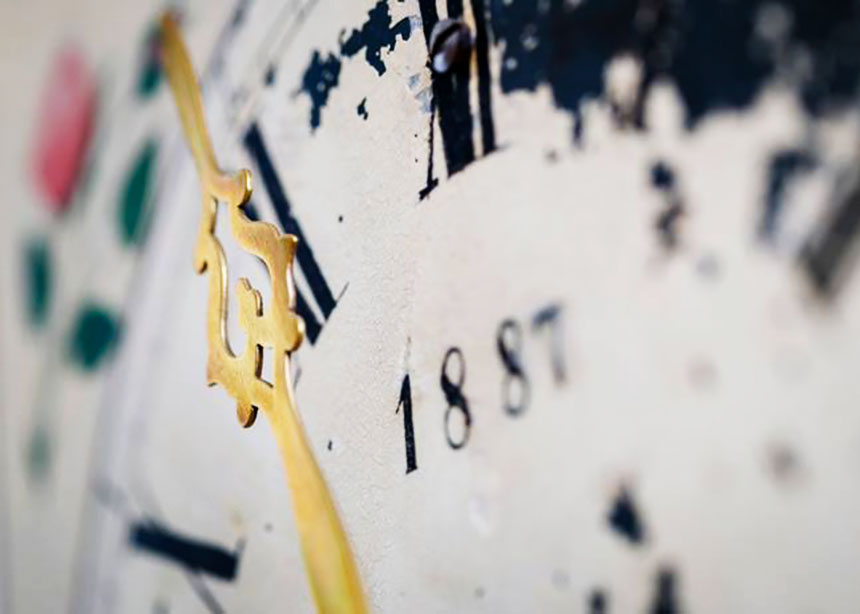



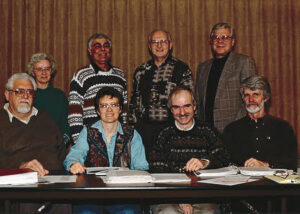


Leave a Reply
You must be logged in to post a comment.